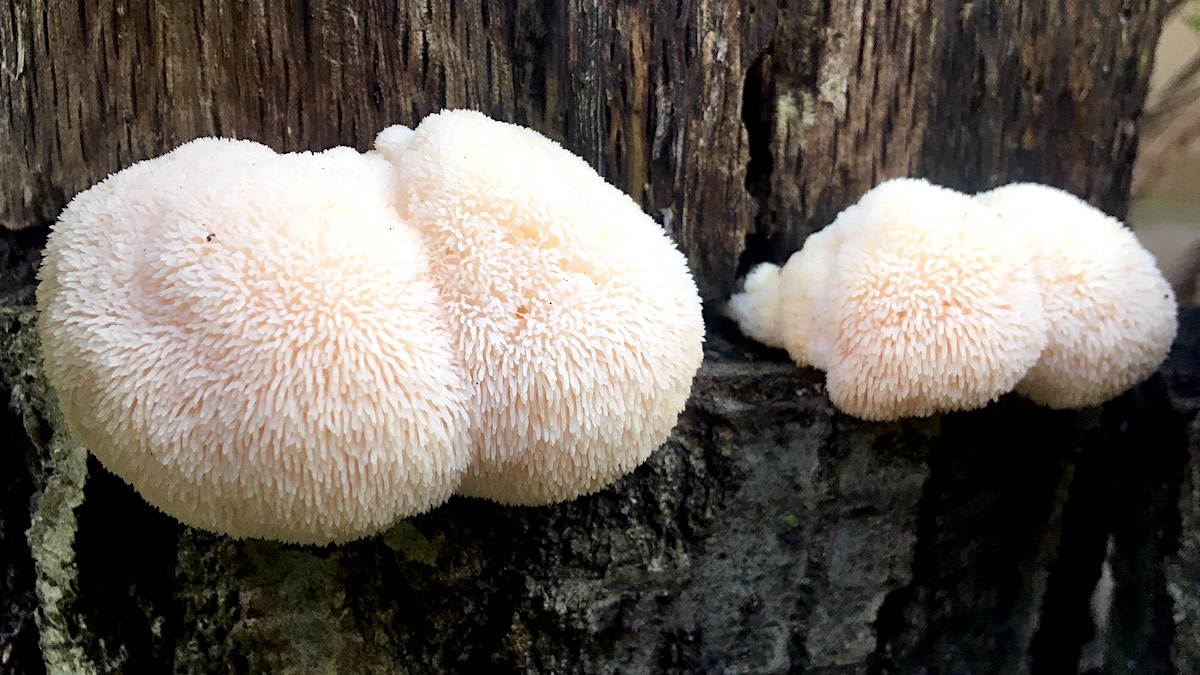
If you’ve ever come across a wild lion’s mane mushroom (Hericium erinaceus), it might strike you as something that came from the deep ocean. The beautiful, cascading spines appear more fit for life on a coral reef than the terrestrial home by which they abide. Fittingly, the texture and flavor of lion’s mane mushrooms is often described as very similar to lobster or crab. I personally don’t think it tastes like crab meat, but I can attest that the texture is almost indistinguishable if picked at its prime.
Beyond the numerous culinary uses, researchers are also studying lion’s mane for its medicinal properties. Some very promising peer-reviewed studies have shown evidence that it can have a positive impact on mental health in patients suffering from dementia and Alzheimer’s. The buzz around these studies and the culinary quality of this mushroom have sparked an explosion of supplements containing powdered lion’s mane and Instagram pages filled with delicious-looking dishes featuring the fungi at fine restaurants. Unfortunately, this popularity has made lion’s mane products prohibitively expensive for the average person, requiring us to forage in their limited season if we want to incorporate them in our diet. Luckily, with access to a few tools and some fresh wood, you can grow your own lion’s mane mushrooms in your backyard.
Some wild fungi like oyster mushrooms have incredibly aggressive mycelium (which is essentially the roots of the mushroom) that can grow on basically any plant material from straw to newspaper to blue jeans. Honestly, they would probably eat us if we let them. Lion’s mane on the other hand is very picky about what it grows on, preferring deciduous hard-wood trees like beech, sugar maple, and hornbeam. We have also had success growing them on oak logs, but they are not generally recommended.
The logs you use need to be cut from living trees to ensure that competing fungus has not already inoculated them. To avoid cutting down living trees, we collect all of our hardwood logs in the early spring when arborists are clearing large limbs around the powerlines in our neighborhood. The ideal time to collect logs for mushroom inoculation is fall through early spring, before the leaves have started to emerge from the trees. The primary reason for this is that the carbohydrates that the mycelium will digest are stored in the wood and roots when the tree is dormant, but when the tree begins forming leaves it pushes a lot of that energy out to the wood.
Once you have your fresh-cut hardwood logs, you want to let them rest for two to three weeks to allow for the tree’s natural immune system to taper off. At this point the logs are a suitable host for the lion’s mane and you just need to select an inoculation method, purchase lion’s mane mycelium, and get to work.
Materials Sawdust and dowel rods inoculated with lion’s mane mycelium are available online. It is technically possible to produce your own inoculated sawdust at home, but it requires a very careful process in a sterile environment, so I would not recommend attempting this for your first batch of mushroom logs.
Once your logs are packed full of mycelium and sealed, you want to place them in a shady part of your yard with plenty of moisture. We keep ours under our willow bushes which provide a thick layer of vegetation to protect them from the sun in the summer, but we can easily move the branches aside to access the mushrooms.
Totem Method for Growing Lion's Mane The totem method is the most common method for growing lion’s mane on logs. First, cut the logs into foot-long sections. Standing the log upright, spread a thick layer of sawdust inoculated with lion’s mane mycelium (more about this below) on the cut. Continue stacking logs and adding layers of sawdust with mycelium between each to create a totem or tower-like structure. To keep out pests and hold in moisture, cover each totem with a paper landscaping bag or a garbage bag until the mycelium fully establishes itself in the wood, which can take over a year.
Drill-and-Fill Method for Growing Lion's Mane This method is how gardeners grow shiitake mushrooms, but it works for lion’s mane as well. This method requires either an angle grinder with a drill attachment or a powerful drill to bore holes every three to four inches around the logs. Pack the holes full of inoculated sawdust and seal them with melted beeswax. The beeswax is essentially performing the same function as the landscaping bag in the totem method by holding in moisture in and keeping pests out.
Dowel Method for Growing Lion's Mane The dowel method is very similar to the drill-and-fill method, but instead of filling the bored holes with inoculated sawdust, you hammer small, inoculated dowel rods into the holes and seal them in with beeswax. Using dowels takes a little bit longer for the mycelium to establish itself in the wood so be extra patient if you use this method.
Grow Kits for Lion's Mane The final method of growing lion’s mane mushrooms at home is to purchase a ready-to-grow kit. I would not necessarily put this in the category of “sustainable home food production” and you will likely pay about the same amount for these kits that you could pay for just buying the mushrooms at the store. That said, it is a fun experiment for kids and a great introduction to growing your own mushrooms.
The Wild Waiting Game Unlike shiitake mushrooms, which have been cultivated for thousands of years and bred for specific traits, lion’s mane is still very much wild and untamed. You can force shiitakes to fruit by submerging them in water overnight, but with lion’s mane you have to wait for it to grace you with its presence naturally, usually in the spring and fall. Lion’s mane also takes much longer to begin producing mushrooms than most cultivated mushrooms, so you’ll need to be patient. You can expect to begin harvesting mushrooms from an inoculated log in about a year and a half. If kept moist and protected from the sun, lion’s mane logs can continue providing you with mushrooms for five to seven years depending on the size of the log.
When you see that first little patch of white forming on your logs and it’s clear that they’re starting to fruit, perform your celebratory dance of choice and then allow it to grow until the teeth are about a half-inch long, at which point it will be meaty and tender. It can take up to a week from the first emergence of the mushroom until it gets to this point, and you will likely be tempted to pick it 100 times before then, so once again make sure to practice patience. Growing lion’s mane mushrooms is an exercise in delayed gratification, but I can assure you that it is worth it in the end.







Conversation